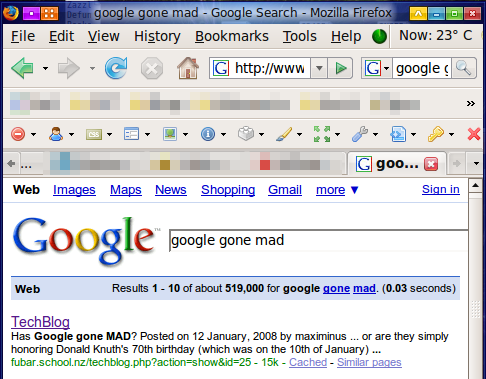Further to my earlier post regarding domain camping / squatting, I've recently stumbled upon a sly tactic from Bitvise, who I've found produce and sell an SSH daemon for Windows. They've purchased the domain name putty.org, and have on it a very basic webpage, with a description of PuTTY and a link to the official PuTTY download page. That's not the bad bit, however.
In addition to these details and this link, Bitcise have details (and links, of course) for their products Tunnelier (essentially an alternative to PuTTY and WinSCP) and WinSSHD. WinSSHD is the one which caught my eye, because for too long, the only way to get SSH access to a Windows machine was using Cygwin. Apparently, WinSSHD has been around for a while also, but I'd never heard of it before - probably because it's commercial software - and it costs $40USD for a single-machine personal license - much more if you need more licenses or are a business or even non-profit organisation. There isn't any mention of it being non-free software on either the putty.org page or the pages that it links to for the Bitcise products
I wouldn't even be quite so annoyed at BitVise's sly tactic if they at least had a decent product - but I tested the trial, and found it to be very poor indeed. Whilst it gave full access to the Windows filesystem (which Cygwin doesn't - at least by default), its shell was absolutely horrible. Its command set appears to be some kind of mixture of Windows/DOS and unix commands, and it has serious issues if you try using a terminal window larger than the default size. It also seemed to have difficulty actually displaying any more than one screen of text - it didn't allow scrolling, and it didn't clear the previous content, so after the end of the new line, the rest of the previous line would still sit there. When I saw this, I couldn't be bothered testing any more, and immediately uninstalled the trial, because there's no way that it could be usable in that state.
Maybe it's not too bad if all you want is secure remote access to a Windows PC's filesystem - I didn't try using it for SCP, but they claim that it performs well when used with Tunnelier. It might even do alright if you only want to tunnel other services (such as Remote Desktop or VNC) through the SSH connection (which would have been my primary use, as I used to use Cygwin for, before it decided that it no longer wanted to work on my PC).
That's not really the point of this post, anyway. The point is that Bitvise are using a tactic which is essentially domain squatting, making it look as though it's somehow linked to PuTTY, and using it as a vehicle to advertise their commercial software, which they are essentially passing off as free/open-source software (by failing to mention anything about it being commercial software or how much it costs) in order to draw you in. This really bugs me, because they're using underhand tactics to try to steal market share from free software.
In addition to these details and this link, Bitcise have details (and links, of course) for their products Tunnelier (essentially an alternative to PuTTY and WinSCP) and WinSSHD. WinSSHD is the one which caught my eye, because for too long, the only way to get SSH access to a Windows machine was using Cygwin. Apparently, WinSSHD has been around for a while also, but I'd never heard of it before - probably because it's commercial software - and it costs $40USD for a single-machine personal license - much more if you need more licenses or are a business or even non-profit organisation. There isn't any mention of it being non-free software on either the putty.org page or the pages that it links to for the Bitcise products
I wouldn't even be quite so annoyed at BitVise's sly tactic if they at least had a decent product - but I tested the trial, and found it to be very poor indeed. Whilst it gave full access to the Windows filesystem (which Cygwin doesn't - at least by default), its shell was absolutely horrible. Its command set appears to be some kind of mixture of Windows/DOS and unix commands, and it has serious issues if you try using a terminal window larger than the default size. It also seemed to have difficulty actually displaying any more than one screen of text - it didn't allow scrolling, and it didn't clear the previous content, so after the end of the new line, the rest of the previous line would still sit there. When I saw this, I couldn't be bothered testing any more, and immediately uninstalled the trial, because there's no way that it could be usable in that state.
Maybe it's not too bad if all you want is secure remote access to a Windows PC's filesystem - I didn't try using it for SCP, but they claim that it performs well when used with Tunnelier. It might even do alright if you only want to tunnel other services (such as Remote Desktop or VNC) through the SSH connection (which would have been my primary use, as I used to use Cygwin for, before it decided that it no longer wanted to work on my PC).
That's not really the point of this post, anyway. The point is that Bitvise are using a tactic which is essentially domain squatting, making it look as though it's somehow linked to PuTTY, and using it as a vehicle to advertise their commercial software, which they are essentially passing off as free/open-source software (by failing to mention anything about it being commercial software or how much it costs) in order to draw you in. This really bugs me, because they're using underhand tactics to try to steal market share from free software.
